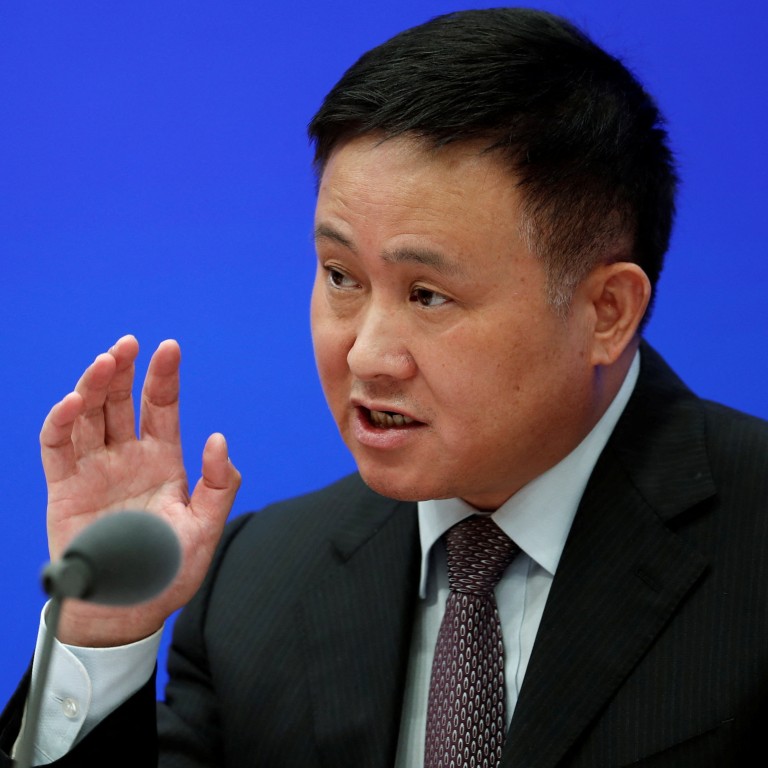- People’s Bank of China governor Pan Gongsheng says risk monitoring will be stepped up, after debt problems manifested at major developers Evergrande and Country Garden
- Policymakers are also urged to tailor policies to the different market realities in various Chinese cities

The cabinet’s finance work report to China’s top legislature over the weekend could signal that policymakers are racing to defuse widely watched risk points such as mounting debt in the world’s second-largest economy, analysts say as the woes of ailing developers and a local-level debt debacle continue to erode investor confidence.
Chinese authorities will prioritise the tackling of key risks to defend their bottom line of no systemic risks, and this will include restructuring small financial institutions while conducting better risk-monitoring of large banks and local financing vehicles, according to the State Council’s report, presented by People’s Bank of China (PBOC) governor Pan Gongsheng.
Regulators will also improve monitoring, assessments and early warnings of debt risks involving large enterprises, especially developers akin to Evergrande and Country Garden.
And outward-facing, Pan said, regulators aim to normalise audit cooperation with the United States, in line with a bid to manage external financial risks, and have vowed to set up an early-warning and risk-prevention system for outbound investment.
Such State Council finance work reports, submitted to the Standing Committee of the National People’s Congress (NPC), are relatively new. This is just the second one since last October. It is also Pan’s first “report card” to the NPC since assuming office at the PBOC in July.
“You can feel the urgency,” said Bala Ramasamy, an associate dean at the China Europe International Business School in Shanghai. “[Beijing’s] focus on protecting the financial system and clearing the mess in the property sector is about getting to the root of the problem to consolidate confidence and the economy’s footing.”
Despite looming economic risks, the Chinese economy gathered steam in the third quarter of this year, with gross domestic product (GDP) expanding by 1.3 per cent from the second quarter and by 4.9 per cent year on year. That gives Beijing more breathing room as it comes to grips with financial challenges and gets to their root.
Pan stressed the importance of tailoring policies to the different market realities in various Chinese cities.
“We will guide various localities to implement differentiated, city-specific credit policies, to increase financial support to ensure project deliveries, and to meet the reasonable financing needs of developers,” Pan said.
He also said the PBOC would promote mergers and reorganisations for “high-risk small and medium-sized financial institutions”.
“We’ll clear out those that need to be cleared,” he vowed.
Alicia Garcia-Herrero, chief economist for the Asia-Pacific region at French investment bank Natixis, noted that small banks “are more exposed to [indebted] local government financing vehicles (LGFVs) of their local governments”.
“Big banks will probably need to absorb some” of the small banks, she said. “Others might need to be let go, so we should expect a restructuring.”
Garcia-Herrero noted that consolidating and merging small banks must be done in tandem with restructuring local financing platforms.
“The risk is increasing because of [small banks’ LGFV] exposure to local government,” she said. “Our estimate is that between 13-15 per cent of small and medium-sized banks’ assets are with local governments, or LGFVs, versus 2-3 per cent for developers.”
Pan’s report said the central bank would adopt a flexible approach to resolving debt risks facing local financing platforms, coalescing the efforts and the main responsibilities of local authorities for debt restructuring and reduction.
Since September, some provinces have issued more than 900 billion yuan (US$123 billion) worth of refinancing special bonds to repay off-sheet debt.
“This marks China’s first step, but a debt-swap programme of 1 trillion yuan alone is insufficient,” Serena Zhou, a senior China economist at Mizuho Securities Asia, wrote in a recent report.
The total size of China’s local financing-vehicle debt is between 55 trillion and 65 trillion yuan, according to Zhou.
“More than half of LGFVs are unable to meet their interest payments or repay maturing debt without the government’s help,” Zhou said. “Restructuring maturing LGFV debt with major banks at lower interest rates and with longer repayment periods will mitigate risks, albeit at the expense of bank earnings.”
Natixis’ Garcia-Herrero said that audit cooperation discussed by Pan was already well established, and a win-win scenario for both the US and China.
“US stock markets need more Chinese listings, and China needs to cut the number of listings onshore and in Hong Kong, given the terrible performance this year,” she said. “Still, the US could backtrack if the auditors are not allowed to do their job properly, so this issue needs constant monitoring.”